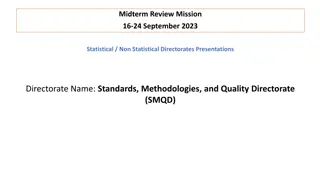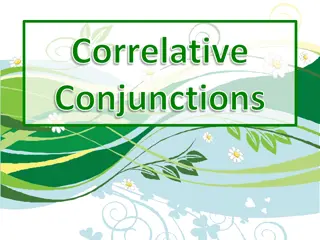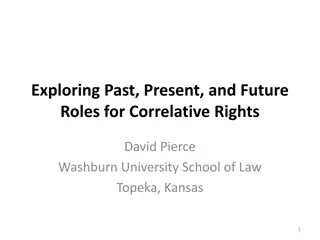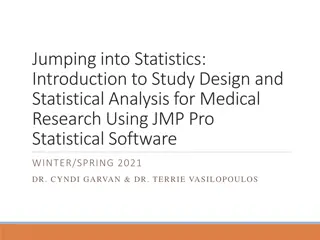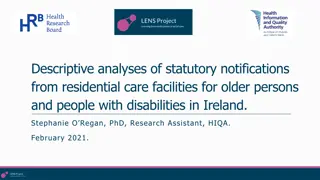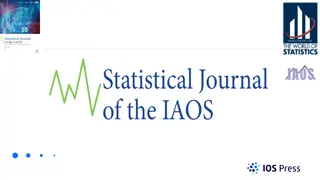
Statistical Aspects of Correlative Studies in Biomarker Research
Delve into the statistical aspects of correlative studies in biomarker research, emphasizing the importance of clear objectives, rigorous design, and thorough statistical considerations. Explore parallels with clinical trial design and grasp the significance of planning correlative studies meticulously for unbiased and meaningful outcomes.
Download Presentation

Please find below an Image/Link to download the presentation.
The content on the website is provided AS IS for your information and personal use only. It may not be sold, licensed, or shared on other websites without obtaining consent from the author. If you encounter any issues during the download, it is possible that the publisher has removed the file from their server.
You are allowed to download the files provided on this website for personal or commercial use, subject to the condition that they are used lawfully. All files are the property of their respective owners.
The content on the website is provided AS IS for your information and personal use only. It may not be sold, licensed, or shared on other websites without obtaining consent from the author.
E N D
Presentation Transcript
Statistical Aspects of Correlative Studies Slightly modified version based on talk by: Meredith M. Regan, ScD Dept. Biostatistics and Computational Biology Dana-Farber Cancer Institute 2014 ASCO/AACR Methods in Clinical Cancer Research Statistical Aspects of Correlative Studies 1 Regan
Goals Appreciate the parallels in clinical trial design and conduct and biomarker research design and conduct, and the need for rigor to eliminate bias Consider what this means for how correlative studies will be planned and written into clinical trial protocol Provide a brief overview of randomized trial designs with integral biomarkers (and prospective biomarker validation) Statistical Aspects of Correlative Studies 2 Regan
Correlative does not mean you can be vague Correlative studies need to be well conceived will you really learn anything? Same principles apply to correlatives for stating aims specifying design and procedures selecting outcome measure -- plus defining correlative measure writing statistical analysis plan *considering power and sample size Statistical Aspects of Correlative Studies 3 Regan
Biomarker Research Principles of clinical research design and conduct apply to biomarker research The research community is establishing similar paradigm and rigor for biomarker research Frameworks [see refs] describe a series of studies, each requires Defining clear objective Specifying design Specifying subject selection Specifying methods and procedures Statistical considerations Statistical Aspects of Correlative Studies 4 Regan
Biomarker Development: Framework Levels of Evidence Hayes et al., JNCI 1996;88:1456 Simon, Paik, Hayes. JNCI 2009;101:1446 Translational Research Working Group Clin Cancer Res 2008;14(18) Sept 15, 2008 Omics classifiers Simon R, JCO 2005;23:7332 Evolution of Translational Omics: IOM, March 2012 (http://www.iom.edu/ Reports/2012/Evolution-of- Translational-Omics.aspx) Screening biomarker development Pepe et al., JNCI 2001;93(14) Pepe et al., JNCI 2008;100:1432 Statistical Aspects of Correlative Studies 5 Regan
Biomarker Development: Framework Analytic Validity ability to measure the analyte or genotype of interest accurately and reliably Clinical Validity ability to detect or predict the associated disorder or phenotype Clinical Utility the balance of its associated risks and benefits if it were to be introduced into clinical practice to be used in clinical situation, requires prospective testing Statistical Aspects of Correlative Studies 6 Regan
Why all the Rigor: Bias A systematic difference between what we [think we] observe and what we actually should observe The more haphazard the data collection process, the more chances of bias creeping in Example: do different labs get different results? Why is bias a problem? Cannot be quantified (within a study) Does not diminish with increasing sample sizes Statistical Aspects of Correlative Studies 7 Regan
Bias Very common: Systematic differences in subject selection and/or specimen collection between groups compared Statistical Aspects of Correlative Studies 8 Regan
Bias Very common: Systematic differences in subject selection and/or specimen collection between groups compared Avoid by prospective uniform collection of specimens in single cohort Statistical Aspects of Correlative Studies 9 Regan
Bias Very common: Systematic differences in subject selection and/or specimen collection between groups compared Avoid by prospective, uniform collection of specimens in single cohort Population or clinical setting that is studied is not the setting for which the biomarker is intended Retrospective case-control studies notorious for spectrum bias: selected case patients tend to have more severe or well-documented disease and selected control subjects are especially healthy, leading to over-optimistic estimates of biomarker performance A major concern in biomarker research is over-fitting bias when performance of biomarker scoring (signature, cutpoint, etc) is evaluated with the same dataset that was used to develop it Publication: failure to publish negative studies Statistical Aspects of Correlative Studies 10 Regan
Over-fitting Bias: Need for Validation It is problematic to develop and evaluate performance with same data Some validation is replication -- assess whether association of marker with outcome is in same direction, of similar magnitude observed in independent dataset Usually multiple studies, with some heterogeneity of population, conducted in multiple labs Some is formal validation of clinical application of model, signature, or testing algorithm, to assess whether expectation is actually observed Statistical Aspects of Correlative Studies 11 Regan
Rigor in Correlative Studies to Avoid Bias Correlative studies need to be well conceived will you really learn anything? Same principles apply to correlatives for stating aims specifying design and procedures selecting outcome measure -- plus defining correlative measure writing statistical analysis plan considering power and sample size Statistical Aspects of Correlative Studies 12 Regan
Correlative Objectives Just as for trial s primary objective, correlative aims should be concrete and include a measurable outcome Objectives are shaped (and may be constrained) by trial s design Examples: To correlate presence of AR amplification, mutation and splice variants with PSA and radiographic response to abiraterone acetate-prednisone and dutasteride To investigate gene biomarkers associated with trastuzumab emtansine-induced grade 2-4 thrombocytopenia, using an unbiased genome-wide assessment of SNPs and CNV Statistical Aspects of Correlative Studies 13 Regan
Correlative Design Aspects Designs are shaped by (may be constrained by) the trial design Things to consider (and clarify in protocol): all patients, or some patients? biological sample (or e.g. functional imaging) and methodology to determine biomarker sampling time points timing of obtaining sample (e.g., prior to dose of treatment) procedures required collection, processing, labeling, storage, shipping assays to be performed with what methodology, by whom/where data pre-processing approach, QC, scoring, etc. Never take for granted that the samples are being obtained as planned! Statistical Aspects of Correlative Studies 14 Regan
Correlative Design Aspects Correlatives may be integral to trial design Parallel groups phase II protocol includes 2 parallel, single-arm trials run in cohorts of patients defined by positive/negative biomarker status marker status may be determined prior to or shortly after enrollment statistical design (single-arm) decision rules for clinical outcome measure may be the same or different in 2 cohorts not designed nor powered to compare outcome between biomarker groups depending on marker prevalence, enrollment rates in the 2 cohorts may be different necessitates sample availability as eligibility criterion Statistical Aspects of Correlative Studies 15 Regan
Correlative Measures Choice of outcome measure: usually 1e efficacy endpoint (eg response, pCR, PFS, OS) could be 2e endpoint, eg, occurrence of a specific toxicity Defining correlative measure What will be quantified in each sample? e.g., ERCC1 mRNA expression; serum androgen levels HER2 expression intensity by IHC (0,1+,2+,3+) presence of AR mutation; presence of HER2 amplification by ISH SUVmax of the hottest lesion and SUVmaxavg of the 5 hottest representative lesions on 18F-FDG and 18F-NaF PET/CT What will be correlated with outcome measure? Only 1 sample: raw value? categorical version (need defn)? Multiple samples: change in level from pre-treatment (or %change, or fold-change)? change in status (e.g., present to absent) Statistical Aspects of Correlative Studies 16 Regan
Correlatives Analysis Plan Analytical plan should be outlined for each correlative objective descriptive or inferential? what will be estimated or compared? what hypothesis test? Statistical Aspects of Correlative Studies 17 Regan
Correlatives Power Considerations Constrained by trial design and sample size Needs to take into account that not all patients will have samples and successful assay results! Power usually considered as detectable effect size with these constraints; shows there has been thought (quantitatively) about what can be learned Statistical Aspects of Correlative Studies 18 Regan
Power Considerations Example: ddMVAC Phase II: evaluate the pathological response of pts with muscle- invasive urothelial cancer treated with neoadjuvant dose-dense methotrexate, vinblastine, doxorubicin, cisplatin (ddMVAC), followed by radical surgery with curative intent (Choueiri, JCO 2014) Response=absence of residual muscle invasive cancer in resected specimen Single-arm, 2-stage design [ =0.10, =0.15] H0: pr(response) 35% vs Ha: pr(response) 55% Reject H0 if 17 of 37 patients respond Correlative objective: Investigate the tumor expression levels of DNA repair genes (eg ERCC1) in relation to response FFPE tumor tissue from previous TURBT or biopsy High tumor tissue levels of ERCC1 mRNA have been associated with clinical resistance to cisplatin-based chemotherapy in ovarian, gastric, cervical, colon and NSCLC patients Statistical Aspects of Correlative Studies 19 Regan
ddMVAC Example: Ideal vs. Reality High tumor ERCC1 expression associated with resistance to cisplatin- based therapy in other cancers Result the investigator anticipates: large, clear difference ERCC1 compared using Wilcoxon rank sum test P<.001 P=.03 P=.24 Ideal (n=37) 55% response Reality (n=37) 55% response Reality (n=27) successful assays 55% response Statistical Aspects of Correlative Studies 20 Regan
ddMVAC Example: Ideal vs. Reality High tumor ERCC1 expression associated with resistance to cisplatin- based therapy in other cancers Statistician anticipates: smaller difference, more variability ERCC1 compared using Wilcoxon rank sum test P<.001 P=.03 P=.24 Ideal (n=37) 55% response Reality (n=37) 55% response Reality (n=27) successful assays 55% response Statistical Aspects of Correlative Studies 21 Regan
ddMVAC Example: Ideal vs. Reality High tumor ERCC1 expression associated with resistance to cisplatin- based therapy in other cancers ERCC1 compared using Wilcoxon rank sum test P<.001 P=.03 P=.24 Ideal (n=37) 55% response Reality (n=37) 55% response Reality (n=27) successful assays 55% response Statistical Aspects of Correlative Studies 22 Regan
ddMVAC Example: Ideal vs. Reality High tumor ERCC1 expression associated with resistance to cisplatin- based therapy in other cancers ERCC1 compared using Wilcoxon rank sum test P<.001 P=.06 P=.60 Diluted Ideal (n=37) 35% response Reality (n=37) 35% response Reality (n=27) successful assays 35% response Statistical Aspects of Correlative Studies 23 Regan
Power Considerations: ddMVAC Assume: 80% samples obtained, 90% assayed (n=27/37) observe 55% response, or 35% response For continuous tumor mRNA expression, 80% power to detect following difference between groups (Wilcoxon rank sum test; 2-sided =0.05): Response: N samples (NoResp+Resp): Detectable difference 55% 55% 35% 35% 37 (17+20) 27 (12+15) 37 (24+13) 27 (16+9) 1 SD 1.2 SD 1.05 SD 1.3 SD Statistical Aspects of Correlative Studies 24 Regan
Power Considerations: ddMVAC Also assess ERCC1 protein in pre-trt tumor tissue by IHC Proportion with high expression unknown (hypothesized to be associated with non-response) For range of prevalence of high expression, 80% power to detect very large differences between groups using Fisher s exact test (2-sided =0.05), with n=37: %Response overall: % High expression: 55% 67% 55% 50% 55% 33% 55% 20% Detectable difference (70% power) High expr, %response 35% 30% 15% 10% Low expr, %response 90% 80% 70% 65% Situation worse when sample size smaller and response rate lower Statistical Aspects of Correlative Studies Regan 25
A Few Words on Biomarker Endpoints Trial s primary objective & endpoint may be biomarker- based, e.g., Compare prostate tissue androgen levels after 12 wks of treatment with either abiraterone acetate + leuprolide acetate and prednisone or leuprolide acetate alone for newly-diagnosed PCa pts undergoing prostatectomy. Assess change in AR transcriptional activity, based on expression of AR-regulated genes, between pre- and on-treatment tumor biopsies, in mCRPC pts treated with HSP90 inhibitor. Compare the endocrine activity of neoadjuvant GnRH antagonist and GnRH analogue in premenopausal pts with primary ER+ breast cancer. Endocrine activity is measured by time to optimal suppression of serum estrogen levels. Crucial to success are Obtaining all samples Assay methodology specified Endpoint definition and biologically-meaningful effect specified Statistical Aspects of Correlative Studies 26 Regan
Prognostic vs. Predictive Biomarkers Prognostic To determine the potential need for further treatment based on the natural history and expected behavior of an individual patient s cancer Theoretically, shown in untreated population; usually shown in population receiving standard treatments Statistically, biomarker associated with clinical outcome Predictive To determine whether specific therapies are likely to be effective Statistically, treatment-by-biomarker interaction On a specific treatment, biomarker associated with clinical outcome; but on other treatment, biomarker not associated with clinical outcome In presence or absence of biomarker, the benefit of treatment vs control is of different magnitude Statistical Aspects of Correlative Studies 27 Regan
Histological Tumor Grade is Prognostic Grading: modified Bloom, Richardson 1957 Statistical Aspects of Correlative Studies 28 Regan
ER is predictive marker of adjuvant CMF chemotherapy benefit in N- postmenopausal patients receiving tamoxifen ER-Negative: HR(CMF>T vs T) = 0.52 (.34 - .79) P=0.01 for treatment-by-ER interaction ER-Positive: HR(CMF>T vs T) = 0.99 (.75 - 1.30) Statistical Aspects of Correlative Studies 29 Regan
HER2+ is prognostic in postmenopausal ER+ disease treated with adjuvant endocrine therapy, but not predictive for choice of aromatase inhibitor vs tamoxifen HR=2.1 (1.6-2.8) HER2- HR(Let:Tam) = 0.72 (0.59-0.87) HER2+ HR(Let:Tam) = 0.62 (0.37-1.03) P=0.60 for treatment-by-HER2 interaction Note, prior to trastuzumab approval Statistical Aspects of Correlative Studies 30 Regan
Randomized Designs There are randomized trial designs with integral biomarkers (and prospective biomarker validation) 1. Enrichment / targeted screen patients for presence of biomarker, only randomize patients who have the biomarker present 2. All-comers (unselected) designs randomize subjects without regard to biomarker status biomarker evaluation may be prospective or retrospective on banked specimens necessitates sample availability as eligibility criterion Statistical Aspects of Correlative Studies 31 Regan
Randomized Designs There are randomized trial designs with integral biomarkers (and prospective biomarker validation) 1. Enrichment / targeted screen patients for presence of biomarker, only randomize patients who have the biomarker present 2. All-comers (unselected) designs randomize subjects without regard to biomarker status biomarker evaluation may be prospective or retrospective on banked specimens necessitates sample availability as eligibility criterion Statistical Aspects of Correlative Studies 32 Regan
All-Comers (Unselected) Randomized Designs Biomarker-stratified design Assess biomarker; in each marker subgroup randomize to trt A vs trt B Design may define sequential testing strategy compare treatments in overall population first, or in specific biomarker subgroup first with control of type I error testing for treatment-by-marker interaction (contrast treatment effects in the two biomarker subgroups) testing treatment effects in each biomarker subgroup separately (each sample size prospectively specified), eg MARVEL Marker-based strategy design Assess biomarker; randomly assign patients to have treatment either based on or independent of the biomarker status Statistical Aspects of Correlative Studies 33 Regan
All-Comers (Unselected) Randomized Designs Biomarker-stratified design Assess biomarker; in each marker subgroup randomize to trmt A vs trmt B Design may define sequential testing strategy compare treatments in overall population first, or in specific biomarker subgroup first with control of type I error testing for treatment-by-marker interaction (contrast treatment effects in the two biomarker subgroups) testing treatment effects in each biomarker subgroup separately (each sample size prospectively specified), eg MARVEL Marker-based strategy design Assess biomarker; randomly assign patients to have treatment either based on or independent of the biomarker status Statistical Aspects of Correlative Studies 34 Regan
Randomized Designs There are randomized trial designs with integral biomarkers (and prospective biomarker validation) 1. Enrichment / targeted screen patients for presence of biomarker, only randomize patients who have the biomarker present 2. All-comers (unselected) designs randomize subjects without regard to biomarker status biomarker evaluation may be prospective or retrospective on banked specimens necessitates sample availability as eligibility criterion 3. Hybrid designs Only certain biomarker subgroups are randomly assigned; others are assigned standard of care 4. Adaptive designs TAILORx Statistical Aspects of Correlative Studies 35 Regan
Randomized Designs There are randomized trial designs with integral biomarkers (and prospective biomarker validation) 1. Enrichment / targeted screen patients for presence of biomarker, only randomize patients who have the biomarker present 2. All-comers (unselected) designs randomize subjects without regard to biomarker status biomarker evaluation may be prospective or retrospective on banked specimens necessitates sample availability as eligibility criterion 3. Hybrid designs Only certain biomarker subgroups are randomly assigned; others are assigned standard of care 4. Adaptive designs Statistical Aspects of Correlative Studies 36 Regan
Randomized Designs Statistical Aspects of Correlative Studies 37 Regan
References Statistical Aspects of Correlative Studies 38 Regan
Biomarker Development: Framework Levels of Evidence Hayes et al., JNCI 1996;88:1456 Simon, Paik, Hayes. JNCI 2009;101:1446 Translational Research Working Group Clin Cancer Res 2008;14(18) Sept 15, 2008 Omics classifiers Simon R, JCO 2005;23:7332 Evolution of Translational Omics: IOM, March 2012 (http://www.iom.edu/ Reports/2012/Evolution-of- Translational-Omics.aspx) Screening biomarker development Pepe et al., JNCI 2001;93(14) Pepe et al., JNCI 2008;100:1432 Statistical Aspects of Correlative Studies 39 Regan
Biomarker Development & Reporting REMARK Guidelines McShane et al., 2005 Aug JNCI and several others Altman et al., BMC Med 2012;10:51 and PLoS Med 2012; 9(5):e1001216 STARD (http://www.stard-statement.org/) Bossuyt et al., Jan 2003 Br Med J and several others Ransohoff. Nat Rev Cancer 2004;4:309 Buyse et al., Nat Rev Clin Oncol 2010;7:309 Expert Rev Mol Diagn 2011; 11(2), 171 McShane & Hayes, JCO 2012;30(34):4223 Statistical Aspects of Correlative Studies 45 Regan
RCT Designs Integrating Prospective Biomarkers Validation Sargent et al., JCO 2005;23:2020 Hoering et al., CCR 2008;14:4358 Clinical Trials 2010;7(5) Mandrekar & Sargent J Thorac Oncol 2011;6:658 and Contemp Clin Trials epub 2013 May 8 Freidlin et al., JCO 2013 Apr 8 epub JCO 2012;30(26):3304 JNCI 2010;102:152 McShane et al, CCR 2009;15:1898 Simon R, Stat Med 2012;31(25):3031 Statistical Aspects of Correlative Studies 46 Regan

